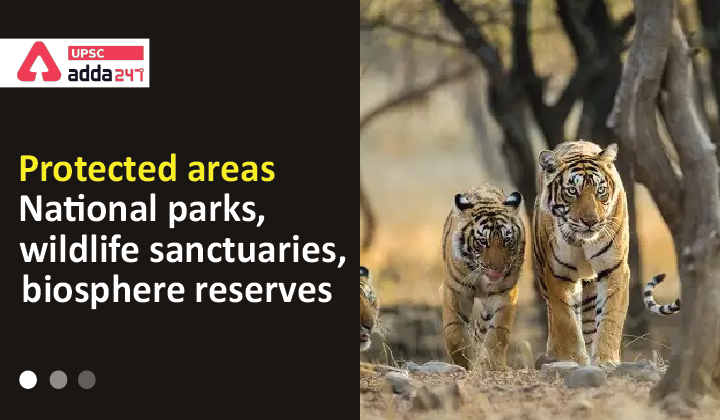Table of Contents
Protected areas of India
Protected areas forms an important topic of UPSC syllabus. Candidates need to have a better conceptual understanding on this topic as questions can be asked from this section in both UPSC Prelims and UPSC Mains. It will be a 2-article series, where in this article we will discuss about the National Parks, Wildlife Sanctuaries, Conservation Reserve and Community Reserve. In the next article, we will discuss about the Biosphere Reserves in India.
Biodiversity of India
- India has only 2.4% of the world’s land area, 16.7% of the world’s human population and 18% livestock, however, it contributes about 8% of the known global biodiversity.
- India is also one of the 17 mega diverse countries of the world.
Protected Area Network in India
- National parks and Wildlife sanctuaries are protected natural habitats, declared by the government under the Wildlife (Protection) Act, 1972.
- There are different categories of protected areas, which are managed with different objectives for the larger motive of conservation.
- A National Board for Wildlife (NBWL), chaired by the Prime Minister of India provides for policy framework for wildlife conservation in the country.
- The National Wildlife Action Plan (2002-2016) was adopted in 2002, emphasizing the people’s participation and their support for wildlife conservation.
What are National Parks?
- National Park is an area having adequate ecological, faunal, floral, geomorphological, natural or zoological significance.
- The National Park is declared for the purpose of protecting, propagating or developing wildlife or its environment, like that of a Sanctuary.
- Here is the list of national parks in India.
What are Wildlife Sanctuaries?
- Sanctuary is an area which is of adequate ecological, faunal, floral, geomorphological, natural or zoological significance.
- The Sanctuary is declared for the purpose of protecting, propagating or developing wildlife or its environment.
- Certain rights of people living inside the Sanctuary could be permitted.
- Further, during the settlement of claims, before finally notifying the Sanctuary, the Collector may, allow the continuation of any right of any person in or over any land within the limits of the Sanctuary.
National Parks and Wildlife Sanctuary difference
The difference between a Sanctuary and a National Park mainly lies in the vesting of rights of people living inside.
| National Park | Wildlife Sanctuary |
| No rights are allowed | Certain rights can be allowed. |
| No grazing of any livestock shall also be permitted. | Chief Wildlife Warden may regulate, control or prohibit it. |
| Removal from a National Park requires recommendation of the
National Board for Wildlife |
any removal or exploitation of wildlife or forest produce from a Sanctuary requires the recommendation of the State Board for Wildlife. |
Conservation Reserve and Community Reserve
Conservation Reserves
- Conservation Reserves can be declared by the State Governments in any area owned by the Government, particularly the areas adjacent to National Parks and Sanctuaries and those areas which link one Protected Area with another.
- Such declaration should be made after having consultations with the local communities.
- Conservation Reserves are declared for the purpose of protecting landscapes, seascapes, flora and fauna and their habitat.
- The rights of people living inside a Conservation Reserve are not affected.
Community Reserves
- Community Reserves can be declared by the State Government in any private or community land, not comprised within a National Park, Sanctuary or a Conservation Reserve, where an individual or a community has volunteered to conserve wildlife and its habitat.
- Community Reserves are declared for the purpose of protecting fauna, flora and traditional or cultural conservation values and practices.
- As in the case of a Conservation Reserve, the rights of people living inside a Community Reserve are not affected.
Also Read:





 TSPSC Group 1 Question Paper 2024, Downl...
TSPSC Group 1 Question Paper 2024, Downl...
 TSPSC Group 1 Answer key 2024 Out, Downl...
TSPSC Group 1 Answer key 2024 Out, Downl...
 UPSC Prelims 2024 Question Paper, Downlo...
UPSC Prelims 2024 Question Paper, Downlo...





